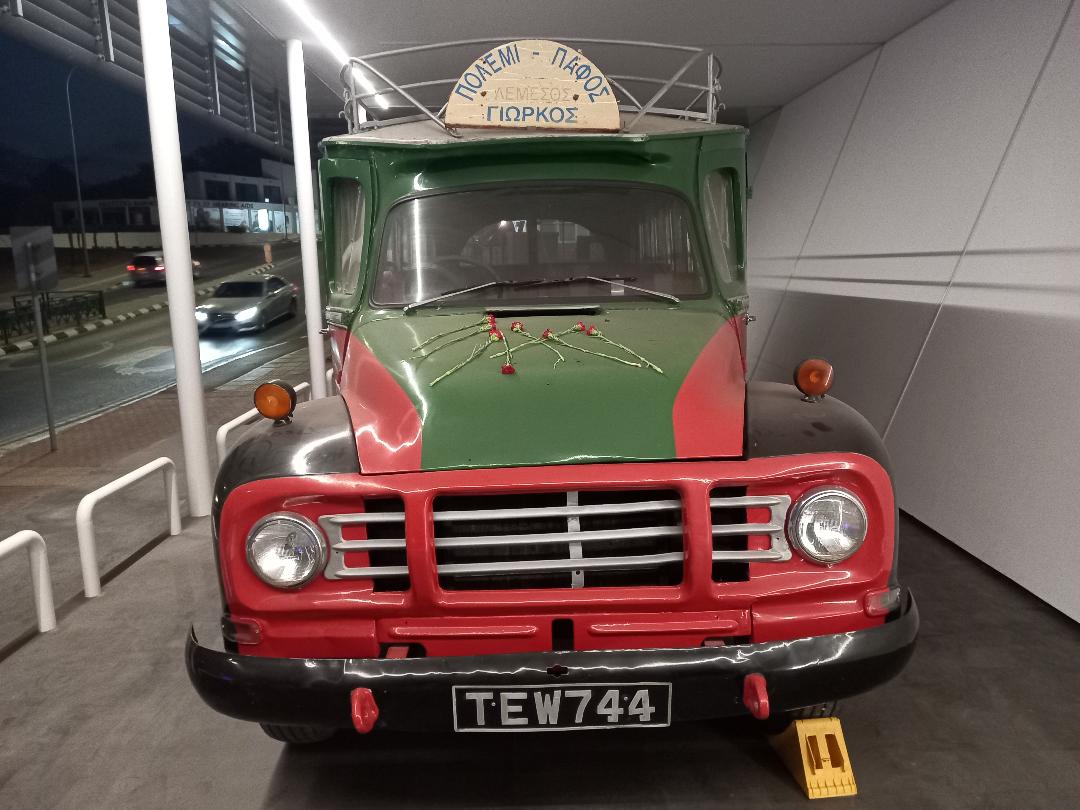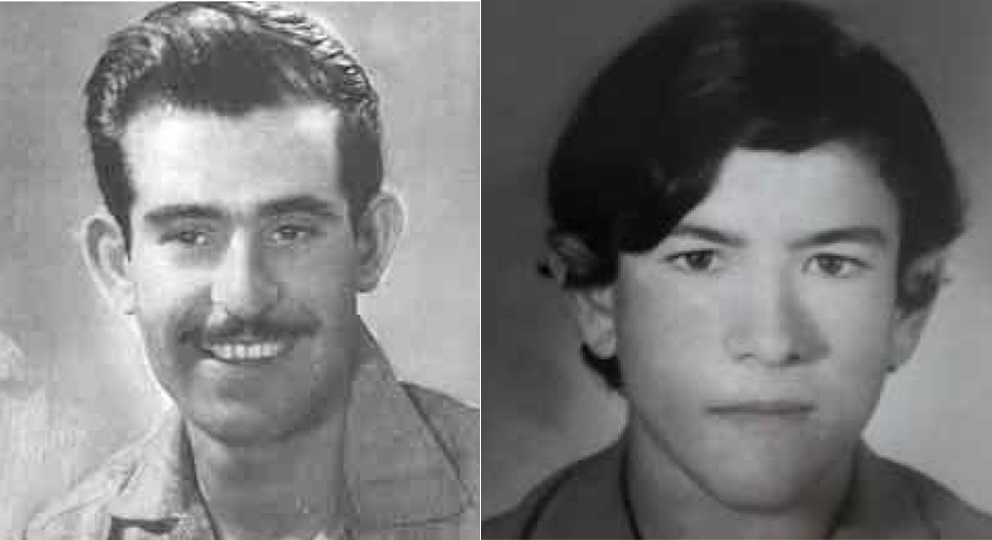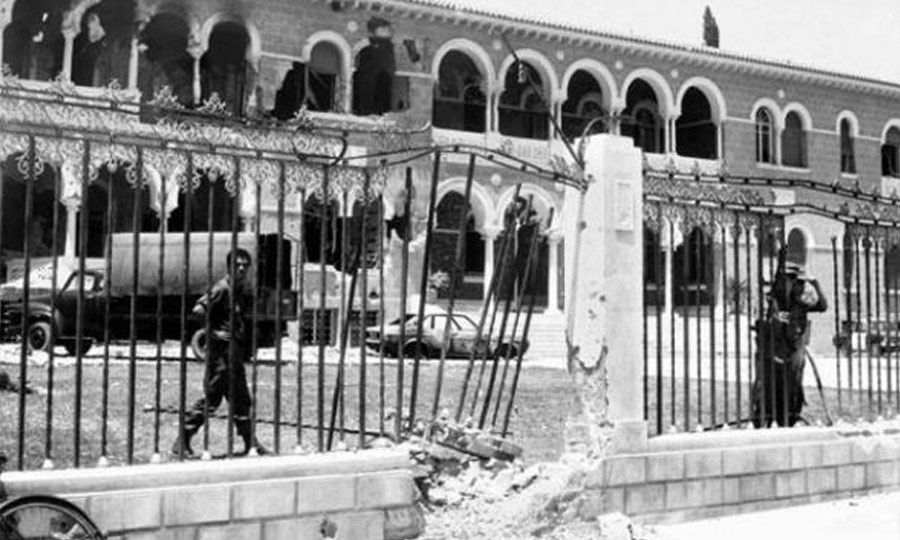

Pavlos Neophytou
In recent months, a freshly painted bus from another era has been placed in a shelter near the roundabout at the Paphos General Hospital. This bus, with its vibrant colors, competes for attention with the nearby fountain. There is nothing on the bus that overtly explains its purpose or meaning. To understand its significance, one must stop and notice the 10 bullet holes on one side and the red carnations placed there by strangers during recent memorials.
For those following recent news, the bus might be familiar from the debates leading up to the local elections, where it was referred to as the "bus of resistance." Disagreements surfaced about the location and timing of the bus's installation, as well as longstanding concerns over its maintenance and its role in preserving history. The Paphos Municipal Council and the Paphos resistance organization rescued the bus from poor condition, intending it to serve as a reminder of those who resisted the coup on July 15, 1974, for future generations.
On the night of July 14, 2024, carnations were placed on the bus near the Paphos General Hospital roundabout.

The occupation of the camps
Around 3:00 PM on July 15, 1974, the archdiocese in Nicosia had fallen to the coup plotters, but President Makarios had escaped and was at the Kykkos Monastery. Paphos and Limassol were still resisting. Andreas Theodorou, president of the Paphos resistance organization, explained that the threat of a coup against Makarios was palpable long before that day. Paphos had a strong organizational structure led by Mikis Temvriotis. On the morning of July 15, after hearing the coup announcement at 8:20 AM, the Paphos fighters decided to act. By 10:00 AM, they had occupied all five military camps in the province and arrested the officers, transferring them to the Paphos Police Directorate without violence. The only officer who resisted was Lieutenant Colonel Ioannis Katerinakis of Ken Paphos, but he eventually surrendered.
Besides the camps, weapons were secured from occupied police stations. Zenonas Sierepeklis, then provincial secretary of EDEK Paphos, described how a convoy of cars, including the "resistance bus," formed and set off towards Nicosia.
The ambush at Kolossi-Zenieris and Makarios

The "bus of resistance" started its journey around 7:00 PM, carrying about 30 passengers. It was ambushed by coup plotters in Kolossi around 8:00 PM. An elderly woman had directed the bus down a road that led to the ambush. The attackers remain unpunished to this day. During the ambush, resistance fighters returned fire, allowing most passengers to escape under cover of darkness. However, 37-year-old Dimitris Zinieris and 17-year-old Andreas Makarios were killed. The survivors were arrested and taken to the Polemidia camp in Limassol. The number of those arrested varies in reports. Zinieris and Makarios were initially buried in Limassol but later reburied in their hometowns.
Reflections
Andros Kyriakides, in his book "When the Tanks Started..." describes the chaos and heroism of that day. Resistance fighters risked their lives to fortify positions and return fire, allowing many to escape. The battle lasted over half an hour, and despite the odds, the lightly wounded and others managed to retreat and hide under the cover of darkness.
This bus, now a silent witness to the past, stands as a symbol of resistance and the enduring fight for democracy.
The bus features 10 bullet holes on one side from fraternal deadly gunfire.
The placement of the license plate by the driver's son
On May 28, 2024, the "Musical Companions" group performed at the installation ceremony of the emblematic bus near the Paphos General Hospital roundabout. The event, produced by Christos Stasis, featured music, speeches, and images about the coup and the bus ambush. Elena Kyprianou, who curated the texts for the event, drew from her research and meetings with the bus’s occupants and their relatives. That night, the children of the late bus driver, Giorgos Agathokleous, surprised everyone by bringing the original sign that indicated the bus route and the driver’s name. As the figure was singing, one of Giorgos Agathokleous’ sons climbed onto the bus and placed the sign in its original position.

The battle of the public garden
Late in the afternoon of Monday, July 15, 1974, after the last bus from Paphos was ambushed in Kolossi, the remaining resistance fighters arrived in Limassol. On the coastal road, they were pinned down by fire from surrounding apartment buildings, especially the "Sevenfold" at the Agios Nikolaos roundabout. Zeno Sierepeklis recalled how the fighters deployed along the road, which was flooded with vehicles from the convoy. Initially heading to Nicosia, they were urged by Elias Kyriakides, head of the Limassol Crime Prevention squad, to stay and hold Limassol, where intense battles were taking place, particularly at the police station.
Sierepeklis described the chaos among the armed crowd from Paphos, who were not a disciplined army but a spontaneously formed group. Some took up fighting positions, while others, possibly regretting their involvement, were uncertain about their next move.
Elena Kyprianou shared a story from a 16-year-old resistance fighter who described how an elderly man, around 75, fell over him during gunfire to protect him, saying, "My son, if a bullet hits you, let it hit me instead, so you can get away."
Sierepeklis noted that the resistance fighters were disadvantaged not due to lack of courage but because of poor communication and organization in Limassol, unlike Paphos, where the resistance was better prepared.
The Limassol Public Garden today. On July 15, 1974, the convoy from Paphos was pinned down on the coastal road, leading to all-night battles.
The retreat and the "ten"
After securing a bridge from the Central Police Station to the coastal road, some Paphites undertook missions in the city. After midnight, with intense fighting continuing at the garden, the resistance fighters in Limassol decided to surrender. At 2:00 AM, upon learning that Makarios had arrived in Paphos, Mikis Temvriotis ordered everyone to return to Paphos. Zeno Sierepeklis organized the retreat. They faced ambushes, and some fighters were left behind, hiding for hours or days.
On Tuesday afternoon, in Paphos, Makarios was persuaded to leave for London via Malta. Sierepeklis noted that the then Metropolitan of Paphos, later Archbishop Chrysostomos I, signaled to stop the armed struggle, as the coup plotters' main target, Makarios, was now safe. However, Temvriotis, Sierepeklis, and others decided to continue guerrilla warfare, hiding in old EOKA hideouts until the Turkish invasion on July 20.
Evaluation
Reflecting on the resistance, Sierepeklis observed that Paphos was unique as its organized democratic forces quickly took control of the camps and police stations, keeping Paphos free until July 16. He criticized Makarios for leaving Cyprus without clear instructions to continue the resistance, leading to confusion.
Sierepeklis, an architect and sculptor, lamented the restoration of the bus, arguing that preserving its original state with bullet holes and broken windows would better symbolize the resistance. Theodorou noted that after the bus was stripped of parts, the Paphos Municipal Council decided to restore and shelter it, preventing it from being discarded.
[This article was translated from its Greek original]































